-
Operation of an Open System Chiller
Posted by golden beaver distillery on May 19, 2020 at 8:17 pmHi
We’re in the process of setting up our distillery and have decided to recycle our cooling water for a number of reasons.
We have 5 ton chiller and two 1,600 gallon wine tanks that will make up the system and a tube-n-tube heat exchanger for crashing our mashes. The still is a 300 gal pot still. The idea is to circulate water from one tank to the condenser or heat exchanger while the chiller is cooling the other tank down for the next day. We will operate as open system – cycling the water from the tank through the chiller back to the tank.
Wondering if others have done a similar system? Any unexpected problems?
hugote replied 4 years, 7 months ago 10 Members · 24 Replies -
24 Replies
-
You might want play around a bit to see if it’s more efficient to just recirculate all 3200 gallons (daisy chain the tanks) vs. single pass 1600 gallons.
1600 gallons and 5 tons is more than enough for the 300 gallon still. We run similarly sized chillers (4.5 ton) and an 800 gallon tank. Two runs back to back is a little bit of a challenge, but one run a day, works great. The chillers run all the time, through the run they help control temp rise, the tank is usually back to our 55f set point by midnight.
We don’t go too cold anymore, the condensation on the non-insulated tank is a real pain during the humid summer months and when we’re mashing.
-
There seem to be a lot of fixed ideas running around this subject. All involving undersizing of the chiller. What this does is to introduce a variable that you do not need into your process.
That being that your cooling media temperature is not dead on consistent for the entire run, and then you are always dealing with time constraints attempting to chase the lack of capacity. This wastes a lot of time and also effort in real terms. If approached from an Industrial perspective, there are other configurations possible that do not even require the secondary cooling arrangement which is also additional cost and more things to go wrong. Trade off and advantages could use careful consideration of several different approaches. Heat can be reclaimed from any cooling media. I am not convinced doing things on what comes off like the ultra cheap way really saves anything for the long term and it costs a major lot of labor and effort along with inconsistent cooling media temp. Something to consider.
-
Our PID-based dephlegmator and product condenser controls completely compensate for tank temperature rise through the run. We hold set points like a rock. Controller increase the flow rate through the run to compensate for the warmer temperatures (reduced delta-t).
Oversizing your condensers is a good option if you are planning to recirculate coolant or use a single-pass water-reuse arrangement (cooling with city water that will be reused for other purposes) – Increase in delta-t means you can squeeze more cooling BTU out of every gallon of water.
-
I have done small and large systems similar to this scenario.
When you are crashing, you’ll have a lot of hot water depending on the output water off the heat exchanger, cooling still not as warm but easier to figure.
I am offering outdoor hybrid water/glycol coolers to crash which matches up really well to a reclaim clean water like you describe. I am getting reading to ship one of these to San Francisco for a smaller distillery and a large 60 ton unit for a distillery in Charleston who uses a separate chiller and stainless tank to chill city water for their still and saves all their warm water similar to what you describe.
I can send you information on the Virga cooler if you want.
-
Silk are you pumping direct from your tank or are you using the chiller pump to pump to the condenser?
-
Starcat the reason I went with 1,600 tanks is to have a large source of water (2x more then need for a run) at the same temp. Our system will pull from the chilled water tank and discharge in the return tank to avoid temperature changes during the run.
-
This is the basic design of my system. Comments welcome.
My equipment is similar to Golden Beaver. Having a process engineer at the local university design and build the control panel. This is to run a 300 gal stripping still and 150 gallon finishing still at the same time. Chiller is 6 ton. Water tanks are 1600 Gallons. Mash chilling is a separate process that will not run with distilling. It is a tube-in-tube heat exchanger. Today we are pumping a glycol water mixture through the mash chiller and we have to watch it as it exceeds the capacity of the chiller and can overheat the glycol and shut down the chiller. We believe 1600 gallons of 55 degree water will get the job done for a 300 gallon mash (actually about 380 gallon as the manufacturer over-sizes his stuff).
That is the idea here… keep the chilled water at 50-55 degrees at all times. The hot water tank is stainless, the cold water tank is poly and insulated. The process dumps the output process water (warm/hot) into the stainless, and the system uses it as input water to the chilled water tank as needed. If running out of water from the hot water tank, the system will inject city water into the loop.
Not using the chiller pump in this design for anything other than pumping glycol through the heat exchange.
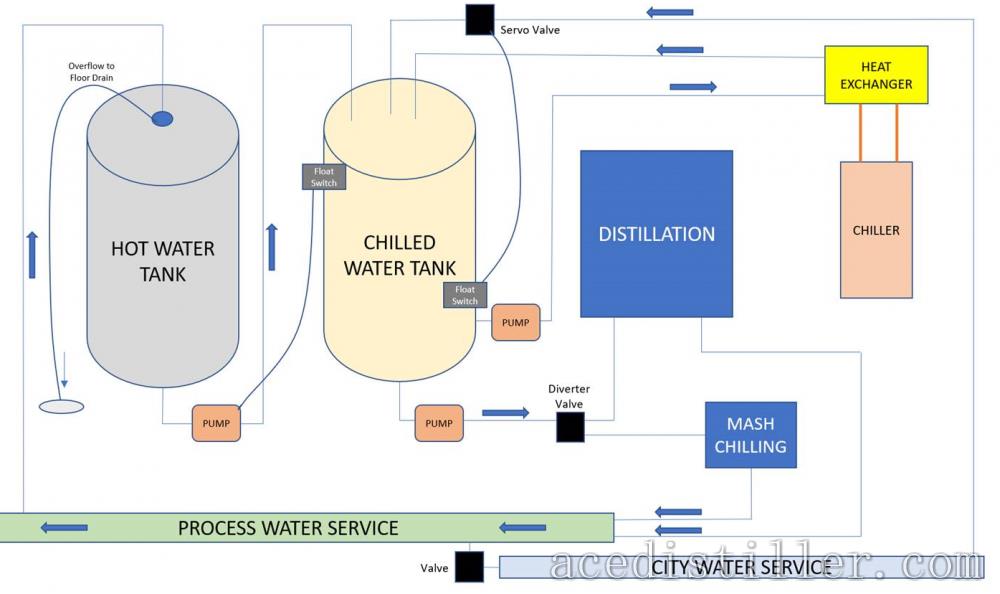
-
Just how many degrees is the hot tank going to be cooled to overnite. With a 5 ton chiller, you’ll be looking at a little imbalance there, especially if you are stripping with the 300 Gal tank.
-
We’ve just complete installation of our cooling water system.
We had to replumb the chiller (reverse flow) to achieve our goal of using the chiller pump to drive the system. Thank you to Advantage Engineering for all the assistance and guidance.
Water is fed from one of the 1,500 gal tanks to the chiller pump which then circulates the water through the heat exchanger then out to process. We have the ability to select the still condenser, either jacketed fermenters or both at the same time, or all three at the same time to receive the chilled water.
The water temp in our test tank dropped from 83 F to 45 F overnight resulting in puddles of water everywhere. We will now have to wrap the pipes and jacket the tanks to avoid this problem.
Our flow is 11 gpm at 40 PSI.
Hoping all we need is one 1,600 tank to manage our cooling needs so I can covert the other tank into a fermenter.
Thank you all for your input.
@Patio29Dadio thanks for hydraulic connector idea…

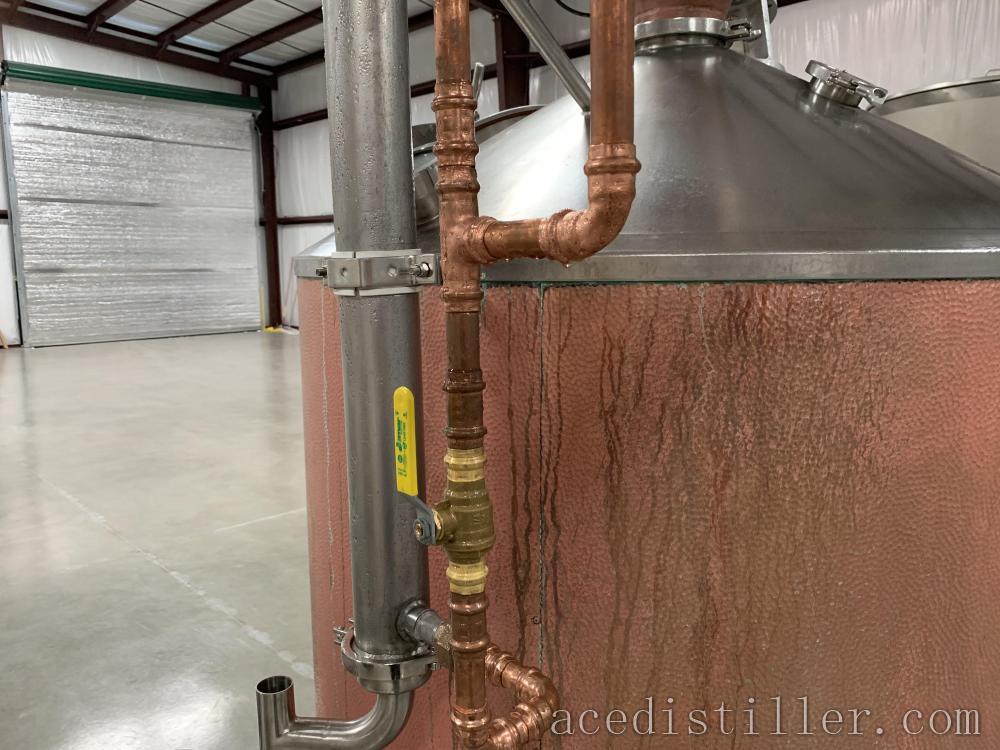
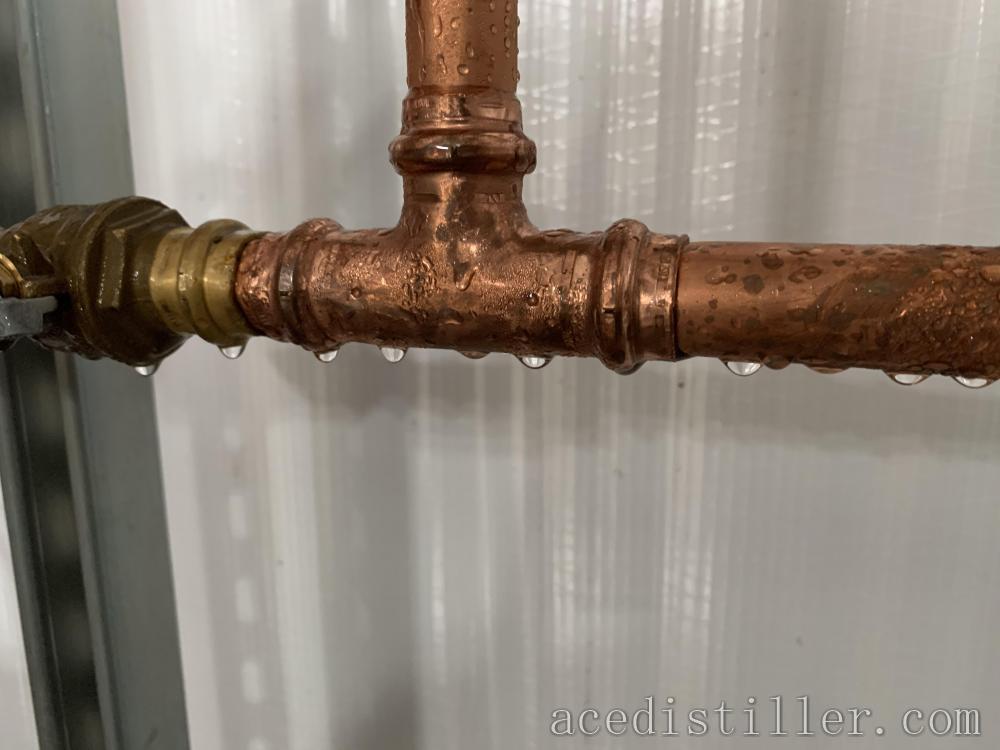
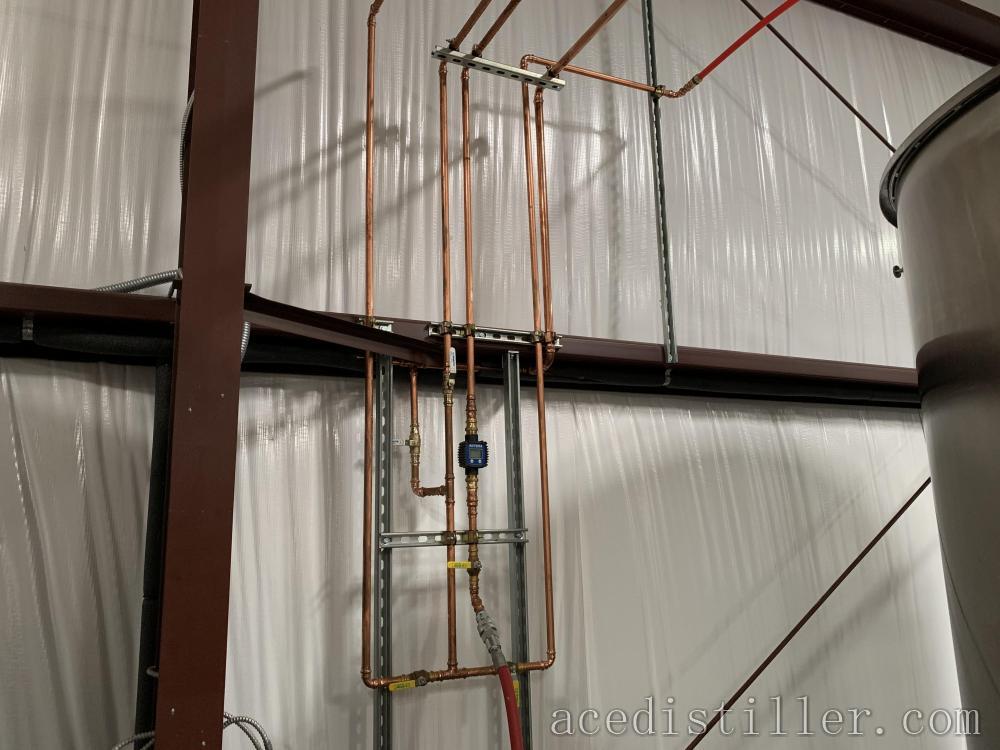


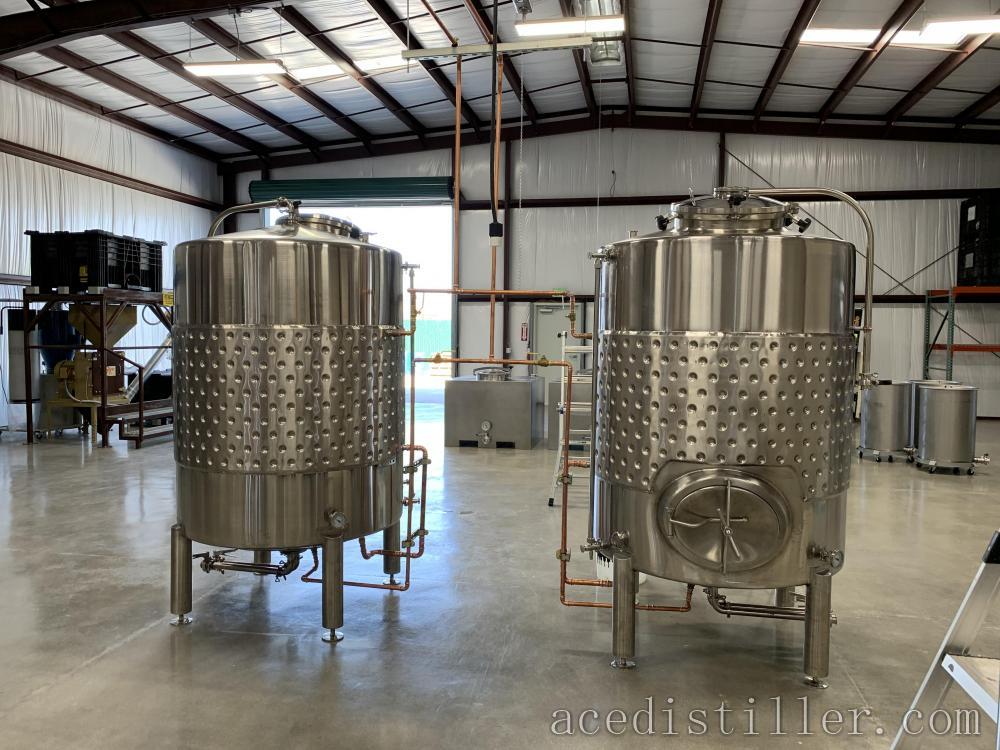
-
I have recently started a distillery in southern IL. I own a 5 ton chiller and have thought of a system similar to this. I think it is a great idea unless there is any chance of the condenser cracking and alowing glycol into your product. That would be deadly. The risk of that would seem low but a consideration. I use a air driven pump that circulates water from a outdoor tank to the still and back out again. I think you have a great idea. You can set your water temp.
-
We’ve removed the glycol tank and plumbed the chiller to “reverse flow”.
Water leave the bottom of the storage tank and flows into the chiller (condenser) then out to the system. The return line discharges at the top of the tank.
This is a more efficient system one based on the use of glycol and less wear on the chiller.
-
We’re talking about propylene glycol, correct? And not ethylene glycol, which should never be used. PG is considered GRAS and commonly found in food, EG is automotive/industrial anti-freeze, is indeed poisonous, and should never be used in a food plant.
-
PG is correct and you need it with inhibitor. ” Dowfrost ” is a known spec, but you can get an equivalent from Chemworld that is just as good.
https://www.chemworld.com/Inhibited-Propylene-Glycol-p/glacier-55.htm
You need to set BRIX with a refractometer to cover below your evaporator range and outdoor temp if you are running a packaged chiller with glycol well outdoors in low ambient. 29 BRIX will get you to about -6F with fair viscosity limit. If you have a chiller in a mechanical room with remote condenser the situation is different. The glycol is strictly about Freeze Protection and you actually lose some efficiency on both heat transfer and pumping when its used, but the advantage far outweighs the added complexity of a glycol to water HX system in many cases.
-
We just run water, we don’t ever chill below 55f. Works fine for us. But – our chillers are indoors – no freeze risk.
Also let’s us dump tanks if we need to.
-
If you run with a complete open system (no isolation exchanger to separate indoor/outdoor flows, then the minimum PG is 30% or else bacteria will actually grow faster. Maximum % is either the ambient outdoor low temp or the operating low temp of the chiller minus 15 degrees to account for refrigerant passing through the chiller which has to be colder than the glycol operating temp in order for the chiller to do its job. In the South, I use 30-35% and up North 40-45%- mainly for cost reasons.
If you have a question in particular, give me a call.
Mike G 678-773-2794
-
Thanks for your sharing and useful information.
Our products are manufactured by the first developer in Taiwan who has a range of machinery and technology for plastics. Today, We have already attracted many foreign inventers that help them expand their production line equipment.
We are offers a variety of industrial water/air chillers that suit a plastic Manufacturing industry .
-
Chillers of the type that are used for this kind of duty generally have a Saturated Evaporator Temp. that can run definitely below 30F. Running straight water on that side of the system can be risky, and best to consult MFG. best practices.
Chillers designed for climate cooling generally run with an Evap temp around 40F, and they are made to run straight water on the DX heat exchanger. I have not found any substitute for the accuracy of a Refractometer in getting then concentration in the correct range.
-
Silk City now that I have gotten into the chiller side more I’m getting some recommendations to use a 10 ton (or 10hp or 100,000 btu per hour- same thing???) chiller for a 100 gallon pot still with 6″ shotgun condenser but it sounds like you are using a smaller chiller and tank for a larger still- and it works! What size still are you running once per day and how did you determine the size chiller?
-
10 ton chiller way to large- more like a 2 HP.
I use 10 HP for a 500 Gal pot, then add if I have fermenter loads, plus reservoir if I have mash cooling.
-
So MG you really think to crash cool 90 gallons of cracked/ground corn mash in 1-2 hours is possible with only a 2 HP chiller? I guess you would need a reservoir for sure- maybe 300 gal? How about stripping the 90 gallons of fermented corn mash in a pot still with 6″ condenser- also possible with 2HP? I think I did some calculation and it required like 30,000 btu/hours so it seemed like you would need bigger.
-
Yes to the reservoir for crashing. If your run calculates 30,000 Btu/hr, you can go up to a 2.5 or 3 HP. If you stretched out the run time by lowering heat, you could get it done with a 2 HP, there is a different style for most chillers, 2 HP being the cut off for the smaller sizes and 3HP for larger sizes which are for sure more hefty. Cost difference could be as much as 3 thousand dollars.
-
Hi,
I’m in the process to start a micro-distillery in a rural area in Sicily, south of Italy.
I asked t an engineer to calculate the size of a similar system, but the power of the chiller and the dimensions of the tanks are much bigger compared with the numbers I’m reading here, 3 times bigger.
Could someone take a look?
I’ll use a 600l (150 gallons) still.
The numbers I got from the still manufactured are the following:
Condenser water in: 20C /68F
Condenser water out: 70C / 158F
1500 liters/ 398 gallons per hour of recirculated water on the condenser
Considering that we’ll distill twice a day during harvesting season I should consider 16 hours of use per day.
398*16= 6300 gallons of HOT WATER to cool EVERY DAY
what we’re missing?
Thanks!
Hugo
Gallardo (2).pdf
-
It looks like you have a calculation error and did not provide complete data for your installation.
For example, it is not clear to me how fast you are going to get alcohol?
I’ll calculate (roughly) myself from your data. And it turns out that you have an error of about two times.
The results of my calculation program:
The volume of a tank with beer (mash) = 600 liters.
Let’s assume that the strength of the mash = 9%.
The reflux ratio is taken equal to = 1.8
The results of calculating the moonshine still:
alcohol withdrawal rate = 12.064 liters per hour.
power input to the tank 600 liters = 20kW (68240 BTU).
Refrigerant (water) temperature at the refrigerator inlet t1, Celsius = 20.0
Water flow through the cooling system Q, liters per minute = 25.0, this corresponds to = 1500 liters per hour.
Average temperature difference between alcohol vapor and refrigerant dtav, Celsius = 70.82
The minimum required cooling area (calculated) F, square centimeters = 795.0 (this is the surface area of all tubes of the shell-and-tube cooler).
Leaving water temperature in the cooling system t1 ‘, Celsius = 31.2
Conclusion from the calculation: at an input of 20 Celsius and an alcohol capacity of 12 liters of alcohol per hour, running water flowing 1500 liters per hour, heats up by only 31.2-20 = 11.2 degrees Celsius.
Okay, let’s assume that the cooling water flows 10 liters per minute or 600 liters per hour, at an inlet temperature of 20 degrees.
Then we get:
The minimum required cooling area (calculated) F, square centimeters = 898.0 (this is the surface area of all tubes of the shell-and-tube cooler).
Leaving water temperature in the cooling system t1 ‘, Celsius = 47.9
Conclusion from the second calculation: at an input of 20 Celsius and an alcohol capacity of 12 liters of alcohol per hour, running water flowing 600 liters per hour will heat up by only 47.9-20 = 27.9 degrees Celsius.
This is a calculation for an alcohol (alcohol) condenser when a moonshine still operates with a tank of 600 liters and a power of 20 kW of supplied energy, the alcohol output is 12 liters per hour.
Hugo, do you have a complete calculation of your setup? I mean a full calculation of the installation work per day? My opinion: for a 20kW heating power, I would not build such a large and expensive cooling unit like yours. This is a lot of money….One truck cooling radiator + fan + water pump with speed control is enough.

-
Alex thank you so much for your response and for the explanation.
I should have studied more physics in school, you just made me a really happy man

I forgot to mention in my previous post a “little detail”, I’ll be distilling with a single pass through a 4 plates column, so once the water leaves the condenser will go to the dephlegmator and that will Increase for sure temperature, but according to you calculations even if the final temp of water was 70C after leave the dephlegmator 600 liters/water x hour will be still ok, right?
Thanks!
Log in to reply.
